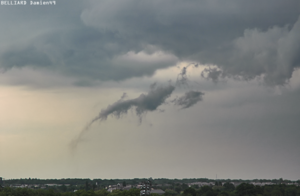Damien49
EF0
Outflow Boundary Tornado : Hybrid landspout-gustnado ?
Hello,
I am a French storm tracker and April 30, 2007, I was confronted with a strange tornado. I know it is a no-mesocyclone tornado (EF0) that developed in front (or long) a shelf cloud. But precisely what kind of tornado ? Is it a landspout, a gust tornado or other ?

You can find more photos of the tornado here : http://www.meteobell.com/__orage_070430_3.php
and the shelf cloud : http://www.meteobell.com/__orage_070430_4.php
Thank you very much. It is very difficult in France to find a clear explanation.
Sorry if this is the wrong section I do not speak English very well, but I'm looking for detailed technical information.
Hello,
I am a French storm tracker and April 30, 2007, I was confronted with a strange tornado. I know it is a no-mesocyclone tornado (EF0) that developed in front (or long) a shelf cloud. But precisely what kind of tornado ? Is it a landspout, a gust tornado or other ?

You can find more photos of the tornado here : http://www.meteobell.com/__orage_070430_3.php
and the shelf cloud : http://www.meteobell.com/__orage_070430_4.php
Thank you very much. It is very difficult in France to find a clear explanation.
Sorry if this is the wrong section I do not speak English very well, but I'm looking for detailed technical information.
Last edited by a moderator:


